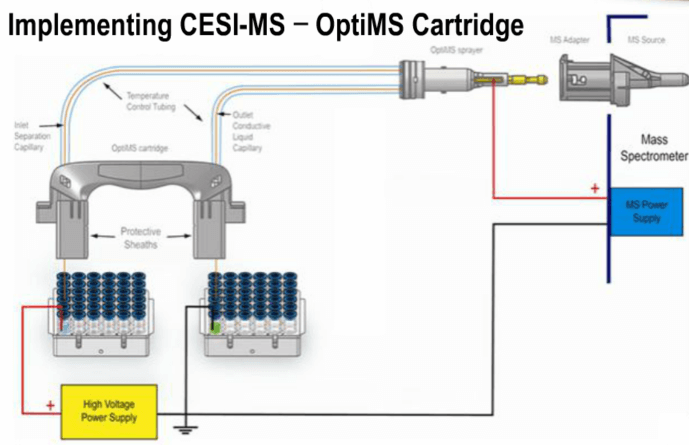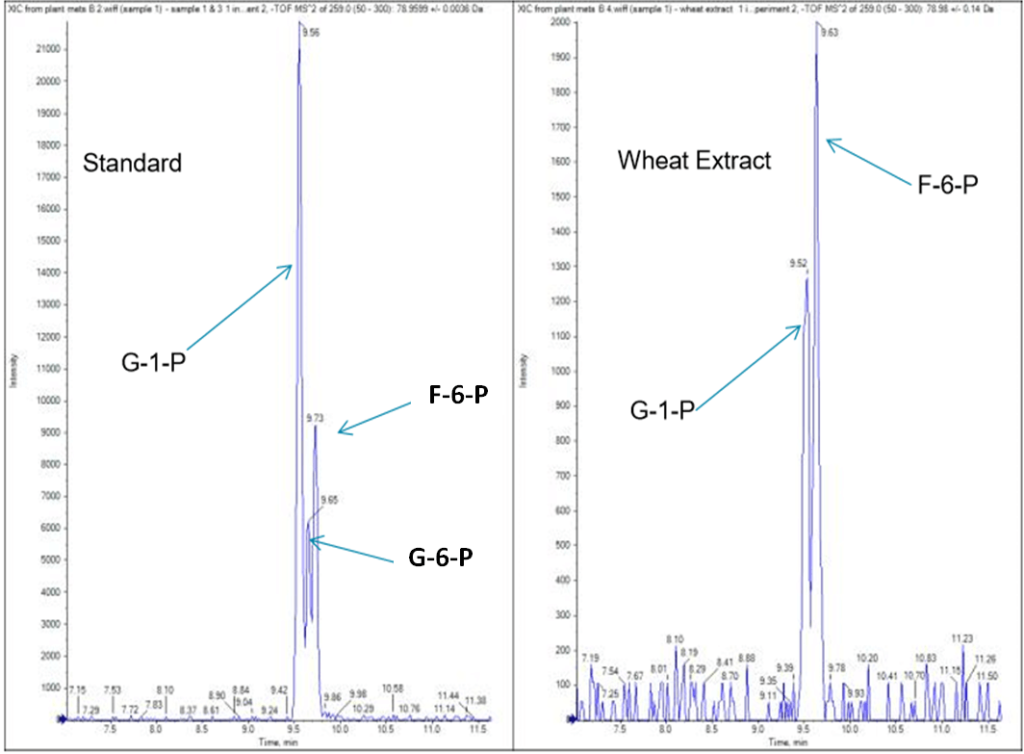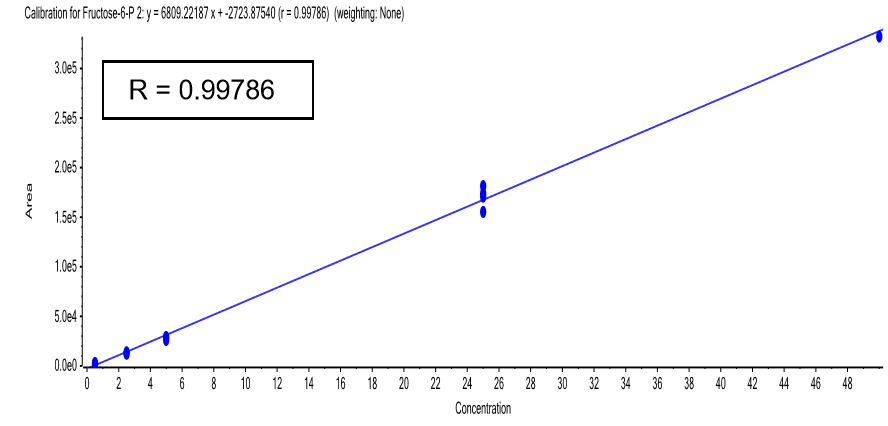 Teasing apart the metabolome: CESI-MS separation of small, anionic compounds
Teasing apart the metabolome: CESI-MS separation of small, anionic compounds
Metabolomics, an emerging field focused on the chemical processes central to cellular metabolism gives scientists a snapshot of the cellular metabolic state, or metabolome at a given time. Highly complex, the metabolome contains a large and diverse group of small molecules and requires a systematic understanding of chemical end-products of cellular processes. Used in conjunction with genomics and proteomics information and researchers can gain a deeper understanding of an organism’s physiology. As a result, insights on a disease’s progress or an organism’s health status become clearer. However, there is a caveat. Teasing apart metabolome components and identifying each molecule is a significant analytical challenge that requires specialized applications and approaches able to separate very small, chemically similar analytes from each other.
To overcome these metabolomic challenges, researchers at SCIEX and Leiden University in The Netherlands developed a novel, highly effective separation method that allows for small, charged metabolites with very similar chemical structures to be differentiated, thereby enabling the resolution of compounds that were once very difficult to distinguish and detect.1 To accomplish this, the scientists used a device called the CESI 8000 Plus (Figures 1 and 2), which pairs the highly efficient chromatography of capillary electrophoresis (CE) with the enhanced ion-producing capacity of electrospray ionization (ESI), combining two techniques into one streamlined process called CESI. When used in conjunction with mass spectrometry, CESI devices provide elegant, high-resolution separations with optimal ionization for sensitive detection of extremely small sample concentrations. By employing this technique, the researchers at Leiden were able to rapidly and efficiently separate and quantitate structurally-similar phosphorylated mono- and disaccharides, which were previously very difficult to resolve.
By using CESI-MS to separate polar and charged metabolites, more complete coverage of the metabolome is achieved. Other analytical techniques, such as liquid chromatography (LC)/gas chromatography (GC)-MS and proton NMR spectroscopy, are unable to resolve many of these small molecules and these analyses may mask hard-to-resolve metabolites. During CESI-MS analysis, compounds elute from the capillary and simultaneously convert into a fine spray of ions resulting in an integrated process that greatly reduces ion suppression, optimizing the number of ions flowing into the mass spectrometer to increase sensitivity. This more efficient ionization approach, combined with enhanced, high-resolution separation of samples, yields improved coverage of many different analyte types for more complete information on a sample’s contents.
Challenges of Analyzing the Metabolome
The analysis of thousands of compounds with substantial chemical variety and dynamic range make simultaneous identification and quantitation of multiple metabolites a significant analytical challenge. To separate anionic metabolites, researchers have historically relied on a reverse phase (RP) chromatography, yet many limitations exist with this approach. First, small, charged molecules interact poorly with RP columns and can pass through without binding. Additionally, columns such as ion exchange, hydrophilic interaction liquid chromatography (HILIC) and Hypercarb (a porous, graphitic-carbon-based packing material) only offer suboptimal separation conditions that require extensive conditioning, long runs, and unsuitable solvents. Finally, because small molecules such as organic acids, amino acids, low-molecular-weight amines, peptides and nucleotides often elute without binding; they are typically not resolved during metabolomics experiments. The difficulty in detecting these compounds leaves many to question the capacity of current metabolomics approaches to capture the full complement of cellular metabolites.
Resolving Structurally Similar Compounds
During their initial studies, SCIEX’s Stephen Lock and Leiden University’s Rawi Ramautar separated compound mixtures with very similar chemical structures that have traditionally been difficult to resolve. They used the CESI 8000 Plus module to test several sets of structural analogs, including disaccharide phosphates, sucrose-6-phosphate (a disaccharide compose of glucose and fructose) and trehalose-6-phosphate (a sugar found in many species of plants that are composed of two glucose molecules). These structural isomers with the same molecular formula were resolved using CESI-MS. Increasing the pressure in two different runs retained the peak resolution and reproducibility (Figure 3). Additional analytes included three isobaric phosphorylated monosaccharides (glucose-6-phosphate, fructose-1-phosphate, and glucose-1-phophate), which previously overlapped after elution from solid-phase columns. Using CESI-MS, all three were successfully resolved from a mixture of standards and an extract of wheat metabolites (Figure 4).
Other small molecule mixtures were also separated into distinct peaks including the citric acid cycle metabolites, citrate and isocitrate (Figure 5), as well as fumarate, malate, and succinate, all with reproducible migration times. Achieving complete resolution was critical for successful metabolite identification because many of these structurally similar compounds displayed identical MS/MS fragment ion spectra, also known as the molecular fingerprint, a mass spectrum obtained where an ion is further fragmented in the mass spectrometer and the fragments are scanned in Q3.
In the second phase of their studies, researchers tested the capacity of CESI-MS to detect metabolites at physiological levels. Calibration curves for 20 metabolites yielded consistently high linear responses (R2 ≥ 0.99, Figure 6) with sufficient sensitivity for detection at intracellular levels (e.g., the limit of detection LOD for monosaccharides was ~100 nM, and for cyclic adenosine monophosphate (cAMP), 10 nM).
Such high levels of consistency and sensitivity during low-abundance metabolite analysis were enabled by the ultra-low flow rates of CESI-MS, which diminishes ion suppression. As molecules flowed through the capillary, the stable spray produced at the emitter tip generated a steady stream of ions for analysis, converting more molecules to the gas phase in the sprayer.3 Additionally, the very small droplets formed at the sprayer tip ionized with higher efficiencies, preserving the narrow widths and high resolution of CESI-eluting peaks. This improvement in sensitivity maximized the detection levels of these metabolites in the low nanomolar to the low picomolar range.
CESI’s high-resolution separations are stationary-phase free and rely on the intrinsic characteristics of analytes. A lack of complex preparation (derivatization) minimizes sample loss to column flow-through and irreversible binding while reducing sample carry-over. The straightforward capillary design also eliminates liquid-liquid junctions and void volumes, while reduced troubleshooting time means a highly efficient, rapid separation with high throughput. These extended advantages have positioned CESI as an indispensable method for studying complex metabolomics samples, with the potential to transition metabolite workflows into high-capacity, high-resolution and high-success endeavors.
Conclusion
CESI-MS is a relatively simple process. The SCIEX/Leiden team separated anionic metabolites using a CESI 8000 Plus High-Performance Separation – ESI Module, which was developed as a tool to improve the front-end separation of polar and charged molecules, while also providing increased resolution and sensitivity before analysis on a TripleTOF® 5600+ System, a high-resolution, accurate-mass platform. The team found that by using CESI-MS, even metabolites that typically co-elute or overlap with structurally similar compounds could be separated from each other. Also, when used in conjunction with the highly sensitive TripleTOF® 5600+ System, this method was sensitive enough to detect metabolites at physiological levels. This CESI-MS-based approach increased in-depth profiling and expanded coverage of charged compounds for metabolomics-based research without having to resort to derivatization techniques to improve resolution or sensitivity.
See What You’ve Been Missing
Future applications of CESI-MS will include methods for accommodating expanded sample types and even more classes of metabolites. For now, using CESI for a more efficient separation of anionic metabolites allows scientists to view a wider range of compounds with higher reproducibility and sensitivity. Metabolomics studies, such as these, are designed to paint a comprehensive picture of the end-products of biological processes, allowing researchers to dig deeper into the metabolome. However, scientists can overestimate, misidentify, or completely overlook a metabolite if it co-elutes with a structurally similar molecule. By performing separations with CESI-MS, a more complete coverage and higher resolution of analogous metabolites can be achieved, elevating metabolomics techniques to a new level.
Written by Laura Baker, SCIEX Technical Support
References
- Lock, S. and R. Ramautar. “A new approach to the analysis of anionic metabolites by CESI-MS with negative ion electrospray ionization.” SCIEX; 2015. RUO-MKT-02-2643-A.
- Lew, C. et al. “Rapid level-3 characterization of therapeutic antibodies by capillary electrophoresis electrospray ionization mass spectrometry.” J Chrom Sci. 2014; 53(3):443-449.
- Busnel, J-M. et al. “High capacity capillary electrophoresis-electrospray ionization mass spectrometry: coupling a porous sheathless interface with transient-isotachophoresis.” Anal Chem. 2010; 82(22):9476-83.
Figure 1. Schematic of the CESI sprayer. The interface between capillary electrophoresis (CE) and electrospray ionization (ESI) in the OptiMS® Sprayer is composed of a separation capillary that has a porous distal end for ion flow and an ESI needle that encapsulates a portion of the emitter tip. Analytes eluting are converted into a fine spray of ions directly at the tip of the capillary with a voltage applied from the ESI needle to enter into the mass spectrometer.

Figure 2. The OptiMS® cartridge for the CESI 8000 System. The CESI 8000 Plus Cartridge is a self-contained unit composed of the sprayer housing, the separation capillary, the conductive liquid capillary, and interfaces with sample vials. The plug-and-spray design makes it easy to connect to any mass spectrometer and allows for easy transitioning between other separation methods (i.e. liquid chromatography).

Figure 3. Separation of disaccharides. A total ion chromatogram (TIC) shows the separation of structurally similar disaccharides, sucrose-6-phosphate (S-6-P) and trehalose-6-phosphate (T-6-P) using CESI-MS. Rapid separation at different pressure settings at the capillary inlet retained the separation resolution.

Figure 4. Separation of monosaccharides. A total ion chromatogram (TIC) shows the separation of three isobaric monosaccharides, glucose-6-phosphate (G-6-P), glucose-1-phosphate (G-1-P), and fructose-6-phosphate (F-6-P) using CESI-MS.
Figure 5. Separation of isocitrate and citrate. A total ion chromatogram (TIC) shows the separation of a mixture of isomers, citrate, and isocitrate, using CESI-MS (upper panel). TICs of individual standards for citrate and isocitrate and their chemical structures are also shown (lower panels).

Figure 6. Calibration curve for fructose-6-phosphate. A wide range of concentrations of fructose-6-phosphate (0.2–200 μM) were evaluated using CESI-MS, and the linearity and the sensitivity of the detection method were assessed.







 Contact Support
Contact Support
0 Comments